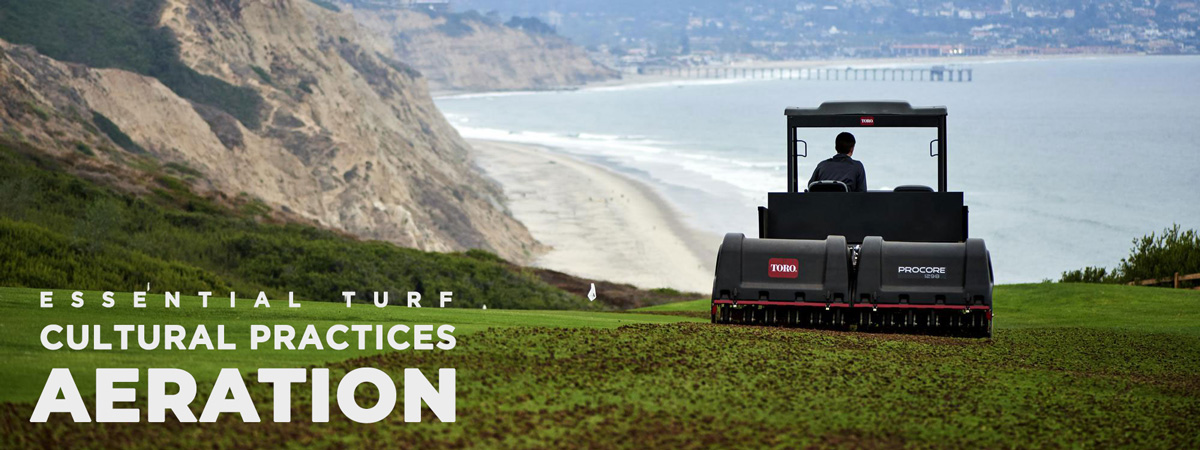Golf course maintenance pose a number of unique challenges to Golf Superintendents.
- During the year, soil conditions can become very compact from the movement of maintenance machinery, Golf Carts and foot traffic, creating unfavorable growing conditions.
- Areas that receive a high level of foot traffic, such as a putting green, deteriorate over time due to soil compaction, thatch accumulation, and day-to-day stress
- The goal is to have a healthier plant by relieving soil compaction, reducing thatch, and improving water and air exchange.
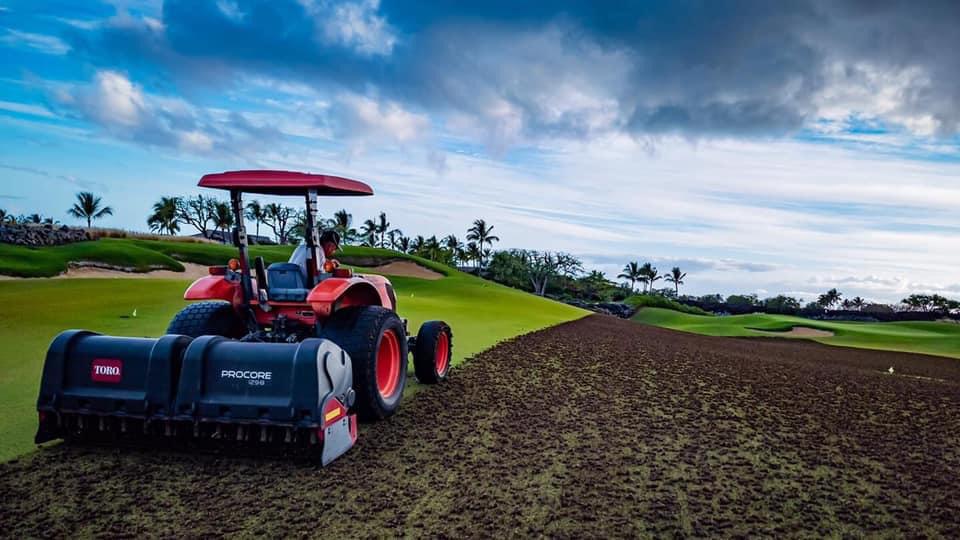
Aeration is one of the most essential cultural practice that provides an opportunity for both turf and soil to recover from daily play, promote turf density and health and helps in providing a good quality playing surface.

Aeration is primarily performed to control organic matter i.e. decaying roots and grass stems, to relieve soil compaction, stimulate root growth and improve drainage.
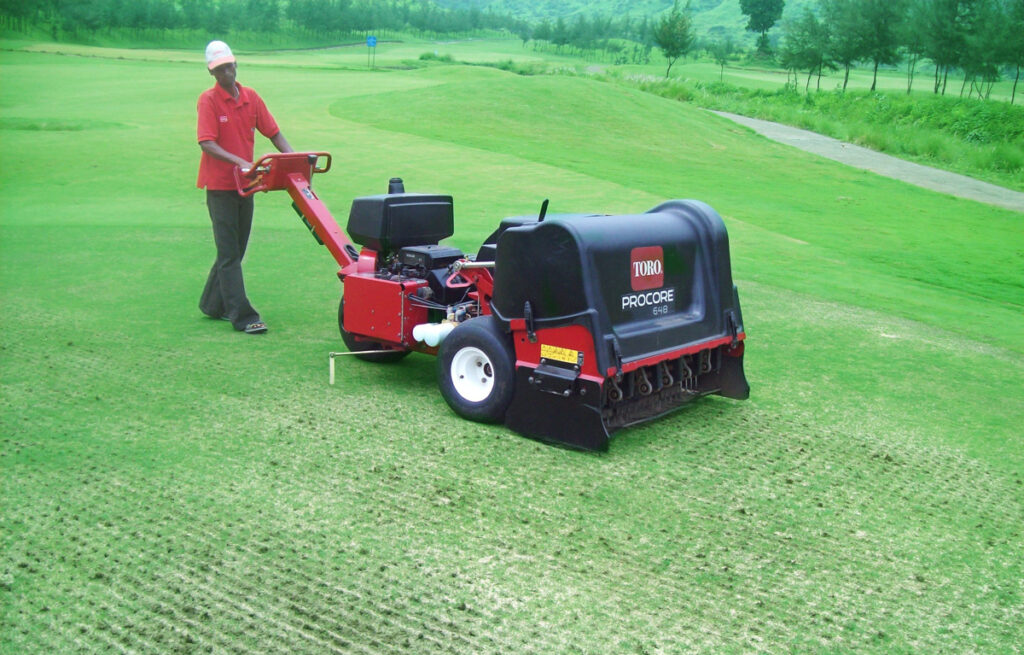
Key Advantages of Aeration
- Relieves soil compaction
- Allows deeper, faster penetration of water, air, fertilizer, lime, and pesticides into the root zone
- Allows for the atmospheric release of toxic gases (e.g., carbon dioxide, carbon monoxide) from the root zone
- Improves drainage, helping to dry out saturated soils and prevent the formation of puddles
- Improves water penetration into dry or hydrophobic soils (e.g., relieves localized dry spots)
- Penetrates the soil layers that develop from topdressing with dissimilar materials
- Controls thatch by stimulating the environmental conditions that promote healthy soil microorganism activity for thatch decomposition
- Increases rooting by constructing a medium more conducive to active root growth
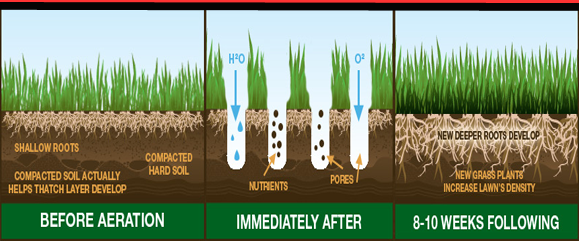
Soil Compaction: One of the prime objective of of core aerification is to relieve soil compaction, which occurs when mineral particles are pressed close together by the movement of maintenance machinery, foot traffic. Soil compaction reduces oxygen (porosity) levels in the soil. A soil should be composed of at least 25% air, on a volume basis, but compacted soil has as little as 5%.
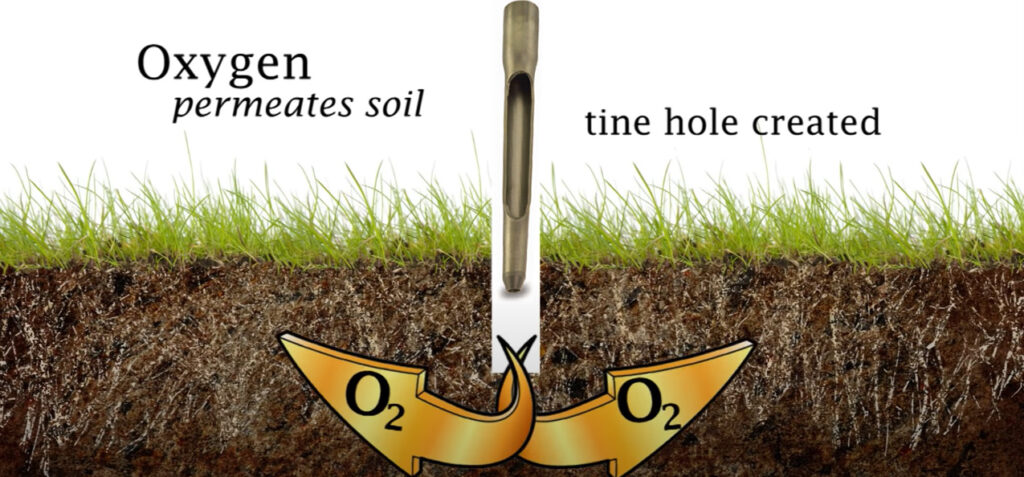
Root function: decreases under compaction due to lack of oxygen needed for respiration and the buildup of toxic gases such as carbon dioxide. Also, roots may be unable to physically penetrate such a tightly packed soil mass. New roots are often abundant along the sides of the aerification holes, indicating the need for increased soil oxygen.
Compacted soil: surfaces also reduce water infiltration and percolation. Dry soils in compacted areas are difficult to rewet. Conditions such as localized dry spots often develop, especially in areas with a high sand content. This encourages the overwatering of adjacent areas. On the other hand, compacted, saturated soils may not drain excessive water and often turn into mud with continued use. Such soils often remain wet for extended periods and become covered with an undesirable layer of algae or moss. The success of highly maintained turf areas such as golf greens depends on the superintendent’s control of soil moisture content.
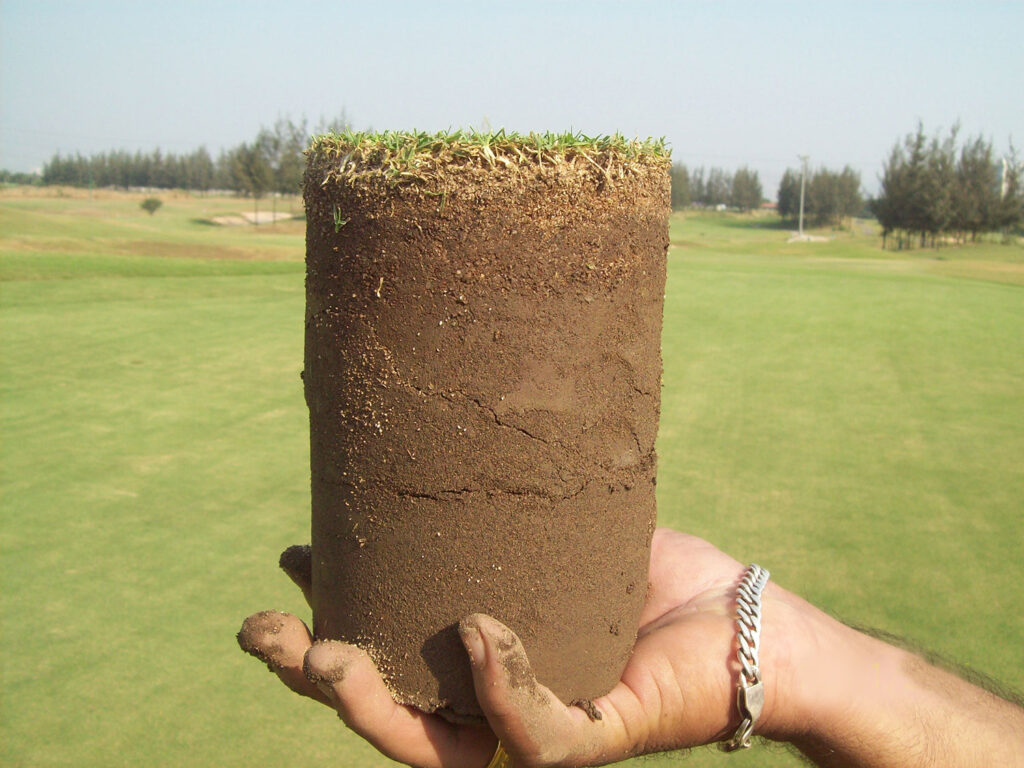
Thatch Management: Some thatch and organic matter are necessary for nutrient/water retention and good playability, but excessive amounts reduce root growth, encourage disease, and create undesirable playing conditions.
- If organic matter becomes too thick, it acts like a sponge and holds water at the surface after rain or irrigation
- Excessive organic matter also inhibits root growth, reduces oxygen levels in the soil, encourages disease and eventually can lead to turf failure
- Further more, excessive organic matter creates soft surfaces prone to ball marks, foot printing and inconsistent playing conditions.
Aeration and Top Dressing are the most effective ways to control organic matter and maintain smooth and firm putting surfaces.
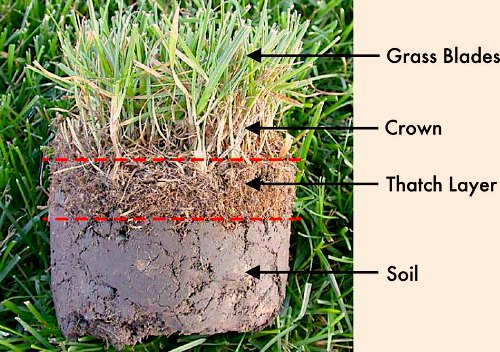
Aeration Timing: Proper timing of aeration will ensure fastest possible recovery and return to smooth surface conditions. The key to a quick recovery is to perform aeration when the turf is healthy and actively growing.
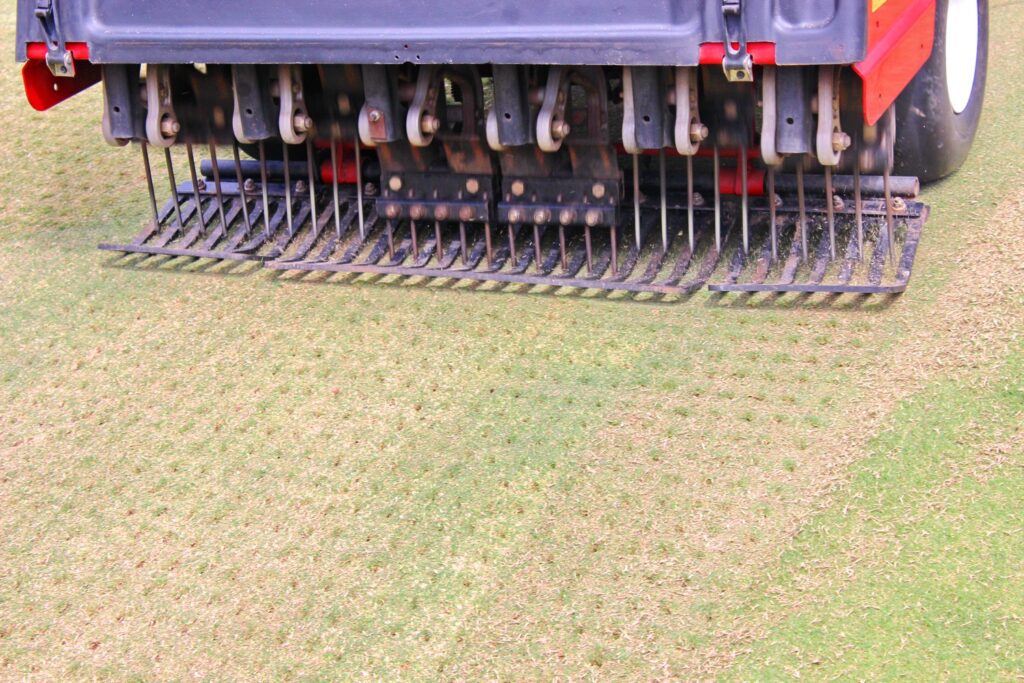
The type and frequency of aeration needed is course specific. Superintendents adjust aeration programs based on soil conditions, turf requirements, climate/weather, available labour and equipment, course events etc.
Aeration Options: Innovations in aeration equipment and technologies now provide turf managers with a wider choice of aeration strategies. Determining what type, size, and depth of aeration can vary by golf course to golf course depending on what option will best solve the existing challenges.
- There are many types of aeration that superintendents use throughout the season. Some are more labour intensive and disruptive to playing surfaces than others.
- Less disruptive forms of aeration, including venting aeration with smaller dia, solid tines also are beneficial because they can alleviate turf stress by promoting oxygen levels in the soil.
- Aeration programs that have a small impact on a playing surface generally can be performed throughout the season with little or no disruption to play
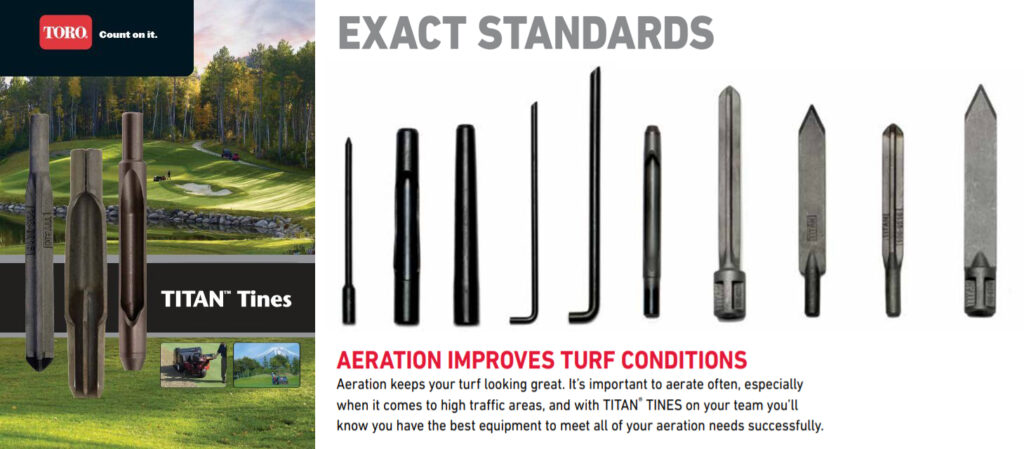
Playing conditions are of utmost importance for most golfers, and aeration is needed to keep turf healthy and playing well. Aeration can be disruptive, but the long term benefits of aeration far outweigh the short-lived disruption.
Core Aeration: Core aeration with hollow tines involves physically removing soil cores from the turf normally 0.25” to 0.75” in dia and is the most common type of aeration. The core size ( 0.25 to 0.75” in dia and depth upto 5 “ ) can be varied by choosing from different sizes of tines options available and with the depth control adjustments in the aerator.
Solid Tine Aeration: Causes less disturbance to the turf surface and can be used to temporarily reduce compaction and soften surface hardness during months when the growth rate of grasses is reduced.
This is an effective tool that can be used to help provide increased gas exchange to root systems and can be particularly useful in alleviating summer stress on putting greens. It can also be performed with minimal impact on putting surface quality when followed by mowing or rolling.
Deep tine Aeration: Aeration with a solid tine is becoming very popular. It provides the ability to reach a depth of 10 inches or greater with a tine’s diameter from 0.25 to 1 inch.
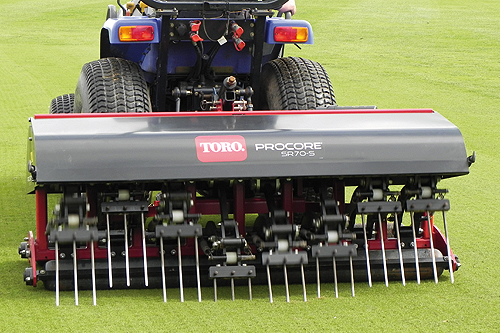
The spacing and angle in which the tine enters and exits the holes can be adjusted. These options do not remove any material and are quick to recover, while still providing positive health benefits.
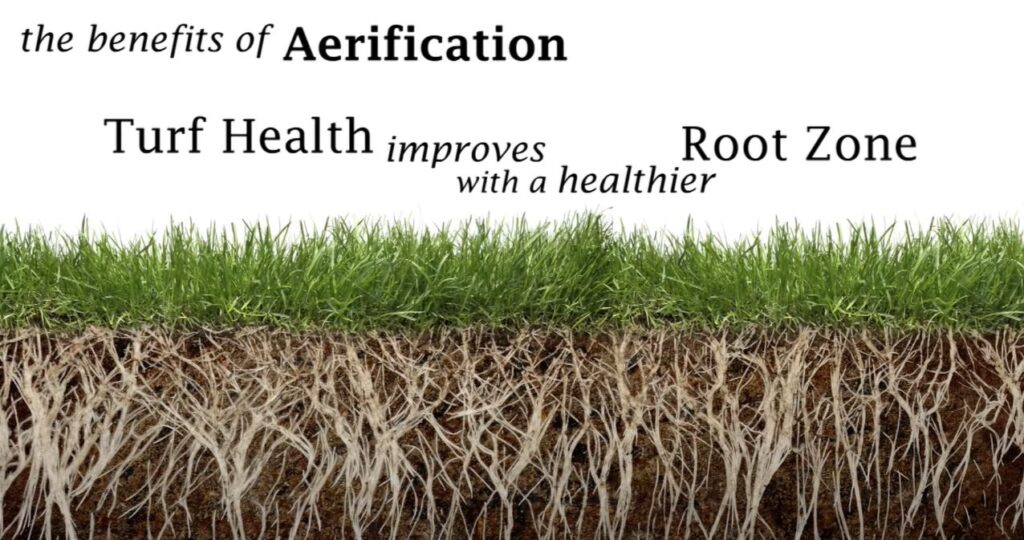
Frequency of Aeration: The frequency of Core Aeration should be based on traffic intensity, level of soil compaction, the amount of accumulation of excessive thatch and organic matter, which reduces root growth, encourages disease, and creates undesirable playing conditions.
Areas receiving intense daily traffic, such as golf greens, approaches, landing areas, aprons, and tees require a minimum of two core aerations annually.
Additional aeration may be needed on exceptionally small greens where traffic is more concentrated, on areas of heavy soils high in silt and/or clay that do not drain well, or on soils exposed to saline or effluent water. Such areas may need aeration with smaller diameter tines (0.38 inch or less) every four to six weeks during the active growing months.
Failure to maintain an aggressive aeration program in these situations will probably result in poorly-drained soils, thin grass stands, and continued problems with algae.
Suggested Products: Toro Procore 648, Procore 864, SR Series Deep Tine Aerators
For more details reach us at:
Email: info@ipi-india.com
Website: https://www.ipi-india.com/golf-course-management.php
